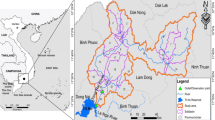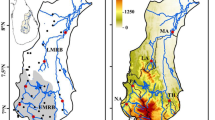Abstract
Population growth, urbanization, and intensified agriculture have resulted in mobilization of nitrogen and phosphorus, which is the main cause of river water quality deterioration. Environmental regulation has expedited the necessity for agricultural producers to design and implement more environmentally suitable practices. Therefore, there is a need to identify critical nutrients and their loss/transport potential. Watershed model can be used to better understand the relationship between land use activities/management and hydrologic processes/water quality changes that occur within a watershed. The objective of the study is to test the performance of the SWAT model and the feasibility of using this model as a simulator of water flow and nitrogen and phosphorus yields over the Dongjiang River basin in South China.
Spatial data layers of land slope, soil type, and land use were combined with geographic information system (GIS) to aid in creating model inputs. The observed streamflow and sediment at Boluo station in the Dongjiang River basin were used to calibrate and validate the model. Time series plots and statistical measures were used to verify model predictions. Predicted values generally matched well with the observed values during calibration and validation (R 2≥0.6 and Nash-Suttcliffe Efficiency ≥0.5) except for underestimation of sediment peaks and overestimation of sediment valleys at Boluo. This study shows that SWAT is able to predict streamflow, sediment generation, and nutrients transport with satisfactory results.
Similar content being viewed by others
References
Arnold J G, Allen P M, Bernhardt G (1993). A comprehensive surface groundwater flow model. J Hydrol, 142: 47–69
Arnold J G, Allen P M, Muttiah R, Bernhardt G (1995). Automated baseflow separation and recession analysis techniques. Ground Water, 33(6): 1010–1018
Arnold J G, Srinivasan R, Muttiah R S, Williams J R (1998). Large area hydrologic modeling and assessment part I: model development. J Am water Resour Assoc, 34(1): 73–89
Borah D K, Bera M (2003). Watershed-scale hydrologic and nonpointsource pollution models: Review of mathematical bases. American Society of Agricultural Engineers, 46(6): 1553–1566
Chen J, Wu Y P (2007). Exploring hydrologic process features of the East River (Dongjiang) basin in South China using VIC and SWAT. IAHS Publication, 319: 116–123
Chung S W, Gassman P W, Gu R, Kanwar R S (2002). Evaluation of EPIC for assessing tile flow and nitrogen losses for alternative agricultural management systems. Trans ASAE, 45(4): 113–122
Easton Z M, Fuka D R, Walter M T, Cowan D M, Schneiderman E M, Steenhuis T S (2008). Re-conceptualizing the soil and water assessment tool (SWAT) model to predict runoff from variable source areas. J Hydrol, 348: 279–291
Gosain A K, Sandhya R, Srinivasan R, Reddy N G (2005). Return-flow assessment for irrigation command in the Palleru river basin using SWAT model. Hydrol Process, 19: 673–682
Green C H, van Griensven A (2008). Autocalibration in hydrologic modeling: Using SWAT2005 in small-scale watersheds. Environmental Modelling & Software, 23: 422–434
Guangdong Soil Survey Office (1993). Guangdong Soil
Jarvis A, Reuter H I, Nelson A, Guevara E (2006). Hole-filled seamless SRTM data V3, International Centre for Tropical Agriculture (CIAT), available from http://srtm.csi.cgiar.org
Muleta M K, Nicklow J W (2005). Sensitivity and uncertainty analysis coupled with automatic calibration for a distributed watershed model. J Hydrol, 306: 127–145
Nash J E, Sutcliffe J V (1970). River flow forecasting through conceptual models: Part I. A discussion of principles. J Hydrol, 10: 282–290
Neitsch S L, Arnold J G, Kiniry J R, Williams J R, King K W (2005). Soil andWater Assessment Tool Theoretical Documentation, Version 2005. Grassland, soil and research service, Temple, TX
Nikolaidis N P, Heng H, Semagin R, Clausen J C (1998). Non-linear response of a mixed land use watershed to nitrogen loading. Agricult Ecosyst Environ, 67: 251–265
Ramanarayanan T S, Williams J R, Dugas WA, Hauck LM, McFarland A M S (1997). Using APEX to identify alternative practices for animal waste management: Part II. Model application. ASAE Paper97-2209. ASAE, St. Joseph, MI
Santhi C, Arnold J G, Williams J R, Dugas WA, Srinivasan R, Hauck L M (2001). Validation of the SWAT model on a large river basin with point and nonpoint sources. Journal of American Water Resources Association, 37(5): 1169–1188
Tolson B A, Shoemaker C A (2007). Cannonsville reservoir watershed SWAT2000 model development, calibration and validation. J Hydrol, 337: 68–86
van Griensven A, Francos A, Bauwens W (2002). Sensitivity analysis and autocalibration of an integral dynamic model for river water quality. Water Sci Tchnol, 45: 325–332
Author information
Authors and Affiliations
Corresponding author
Rights and permissions
About this article
Cite this article
Wu, Y., Chen, J. Simulation of nitrogen and phosphorus loads in the Dongjiang River basin in South China using SWAT. Front. Earth Sci. China 3, 273–278 (2009). https://doi.org/10.1007/s11707-009-0032-6
Received:
Accepted:
Published:
Issue Date:
DOI: https://doi.org/10.1007/s11707-009-0032-6




